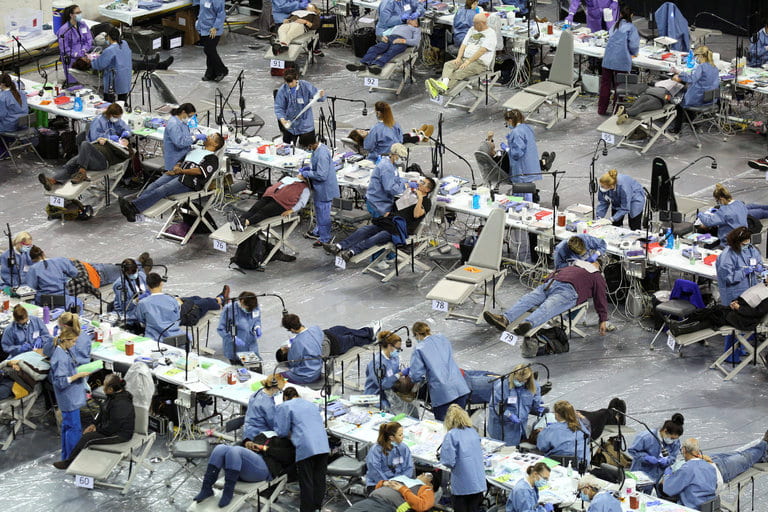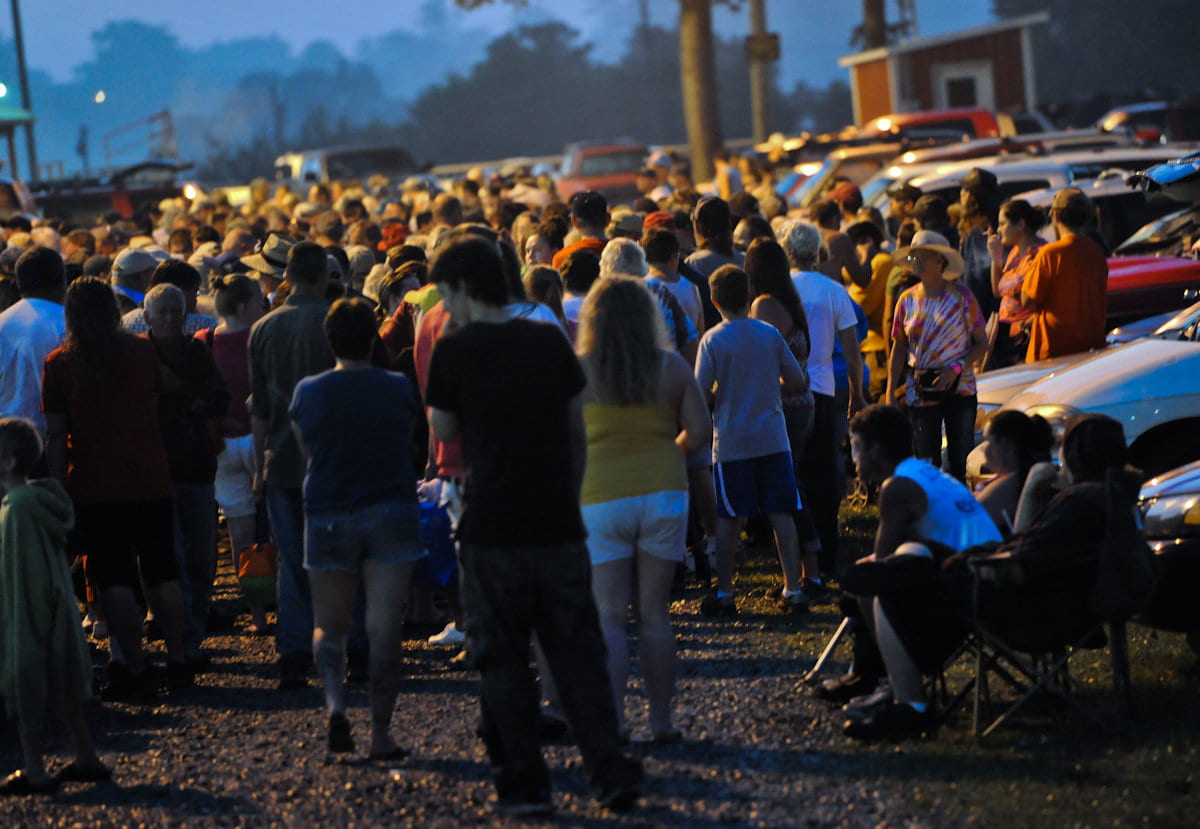
People received free dental work last month during the Seattle/King County Clinic, a four-day event that also offered free vision care and other health services. Credit David Ryder/Reuters
By Ann Neumann
“Although we could not find a single factor whose explanatory power was greater than that of non-college whites, we did identify a group of them that did so collectively: an index of public-health statistics.” —The Economist, “Illness as Indicator,” November 19, 2016
It was the broken Democratic party machine. It was misogyny. It was racism. It was Bernie Sanders and his braying bros. It was poor whites who threw every minority group under the bus for the promise of their own economic salvation. It was the media, transfixed by spectacle and its resulting profits. It was the FBI’s director, James Comey, who kept the story of Clinton’s email misuse in the media. It was white women who betrayed the sisterhood. It was the deluge of raw stories about Donald Trump, overwhelming credulity and preventing any one from sticking, like eggs sliding off Teflon. It was the global perversion of authoritarianism that leapt from Brexit UK to the complacent US. It was clueless elites, blind to the challenges of “real” Americans. It was the electoral college, set to betray the popular vote. It was the meddling Russians. It was the pompous pollsters who distracted us from impending horror with their statistical certainty. It was white evangelicals who traded their prudish morality for the conservative future of the Supreme Court.
The aftermath of November 8th’s election has been a melee of finger-pointing; we’re in a state of blame and flying explanations that demonstrates just what a surprise Trump’s election really was—even to Trump himself. Certainly, as the next four years will dramatically, devastatingly show, there’s enough blame to go around. And also certainly, all of the parties above played a role in Trump’s election—particularly, as Trump’s cabinet appointments are revealing, the Religious Right.
But as new analysis from The Economist shows, the greatest indicator of Trump’s electoral victory was not on the whole any one of those causes touted above and amplified by the media, but rather the drastically declining physical health of a segment of the voting population.
The Economist came to this conclusion after a challenge from pollster Patrick Ruffini on November 15. The “best predictor” of Trump’s win in the initial days after the election was the change in “non-college white” votes from 2012 to 2016—the percentage of potential voters who are “non-college whites” and had not voted for Romney but came out for Trump. “Find the variable that can beat % of non-college whites in the electorate as a predictor of county swing to Trump,” Ruffini said.
The Economist used research from the University of Washington’s Institute for Health Metrics and Evaluation, which had compiled county-level data on “life expectancy and the prevalence of obesity, diabetes, heavy drinking and regular physical activity (or lack thereof).” The Economist writes:
…counties with a large proportion of whites without a degree also tend to fare poorly when it comes to public health. However, even after controlling for race, education, age, sex, income, marital status, immigration and employment, these figures remain highly statistically significant. Holding all other factors constant—including the share of non-college whites—the better physical shape a county’s residents are in, the worse Mr. Trump did relative to Mr. Romney….
… the specific subset of Mr. Trump’s voters that won him the election—those in counties where he outperformed Mr. Romney by large margins—live in communities that are literally dying.
The article notes that Trump voters in this category were not “particularly down on their luck”—higher income voters tend to vote Republican—but when they lived in counties that are physically suffering, they were motivated to go to the polls. The sicker the people in a county, the greater chance that the county would go to Trump. “If an additional 8% of people in Pennsylvania engaged in regular physical activity, and heavy drinking in Wisconsin were 5% lower, Mrs Clinton would be set to enter the White House,” The Economist writes. A hurting segment of the population, blighted by declining life expectancies, voted to change the course of their health. And change is exactly what ailing Trump voters—and the country—will get. “Even if Mr Trump’s policies are unlikely to alleviate their plight, it is not hard to understand why they voted for change.”
***
Even a month before the inauguration, there can be no doubt that the election of Donald Trump is a horror for the future of public health, one that could take us decades to recover from, should the nation’s institutions survive at all. Although Trump has been inconsistent or even self-contradictory about what his policy objectives are throughout the campaign, it’s clear that, in the weeks since the election, he has surrounded himself with a team that will wreak havoc on public health, economic well-being and physical safety. His actions regarding the Affordable Care Act will likely exacerbate the significant health challenges many Americans already face.
How bad is it? Last year Anne Case and Nobel prize winning economist Angus Deaton confirmed what many health workers already knew: the death rates of white, middle-aged Americans are on the rise. “The declining health and fortunes of poorly educated American whites” were falling so dramatically that they were “increasing the death rate for the entire group of middle-aged white Americans,” wrote The New York Times last November when the report was released. The Times also quoted an analysis of the report by Dartmouth economists Ellen Meara and Jonathan S. Skinner that was published by the National Academy of Sciences: “It is difficult to find modern settings with survival losses of this magnitude,” they wrote.
In an article for the Fall 2016 issue of Virginia Quarterly Review, Amy Woolard reported from the country’s largest free pop-up medical clinic on the fairgrounds of Wise County, Virginia where one in five adults and one in four kids live at or below the poverty line. Remote Area Medical, the organization sponsoring the event, was founded by a British philanthropist, Stan Brock, who has also organized “medical missions” to Mexico and British Guyana, places with medical needs seldom considered on par with the rural US. Wollard writes:
Shame, poverty, and the verb beget are at the rotten root of what brings people to RAM clinics. Poverty begets depression and anxiety. Shame begets avoidance. Poor nutrition begets decay. A dearth of doctors and dentists begets poor preventive care. Pain begets self-medication. And it’s cyclical: Missing teeth beget unemployment, begets missing teeth.
The President-elect has somewhat walked back on his promise to repeal Obamacare, but that doesn’t mean that at-risk, financially strapped, ailing populations that have subsidized coverage will be able to keep it. As reported by Ryan Lizza for The New Yorker on November 16, Trump stated the Friday after the election that he would keep two popular parts of the Affordable Care Act: the provision that “requires insurers to accept new customers without regard to preëxisting medical conditions” and “the regulations on insurance companies that require them to allow children to remain on their parents’ plans until the age of twenty-six.” Lizza notes, “This is classic Trump: he is for any policy that is popular, and he made no effort to explain how he would retain these regulations without maintaining the individual mandate, which was the insurance industry’s price for accepting the new regulations when the legislation was negotiated.”

Patients being seen at the Tacoma C.A.R.E. Clinic in 2011.
In addition to Obamacare’s open insurance options, its Medicaid extension may also be changed. On November 16, The New York Times’ health reporter, Robert Pear, considered expected changes to Medicaid. Twelve of the 20-plus million people who obtained coverage under the ACA did so through the Medicaid extension. Regardless of what changes are down the road, Pear speculates that the “Trump administration is almost certain to give states more leeway to run their Medicaid programs as they wish,” requiring “co-payments and work requirements” of those who receive coverage.
Obama has successfully blocked some of the most egregious state requirements: In November the administration halted New Hampshire’s request for proof of citizenship and state residency. When Arizona sought to charge a premium for people above the poverty level (a meager $20,160 a year for a family of three), the Obama administration approved, but they denied the state’s request that recipients also be given a work requirement or a time limit on coverage. Ohio and Kentucky are also seeking restrictions.
As well, Republicans have been trying to cut the overall federal payment for eligible beneficiaries, which will cause the cost of coverage to skyrocket in many states. In early November, Speaker Paul Ryan reiterated his plan to replace Medicaid expansion with “refundable tax credits for people to buy affordable health insurance.”
Vox’s Sarah Kliff reviewed all seven of the Republican plans for replacing Obamacare that have been floated. All of them, including Ryan’s “Better Way” and Utah Senator Orrin Hatch’s “Patient Care Act,” will reduce enrollment and raise premiums. Eighteen million people would lose coverage under Better Way. Nine million would under the Patient Care Act. Kliff writes, “If we can say one thing about most Republican plans, it is this: They are better for younger, healthy people and worse for older, sicker people.”
But the increasing inaccessibility of health coverage is only the most explicit expected change in the future of the nation’s health. Recently at Dame magazine, Marie Mung-Ok Lee, whose son is autistic, highlighted Trump’s mocking of disabled journalist Serge F. Kovaleski, the likely escalation of disastrous policing policies regarding the physically and mentally disabled, and the presence of former New York police commissioner Rudy “shoot first, ask questions later” Guiliani in Trump’s circle. “As a parent ever alert to changes that may affect my son, the election results add another fold in the complex and fragile origami that holds our son’s life together. Can we count on the Americans with Disabilities Act as any kind of protection in a looming ‘law and order’ Trumpian world?” Lee writes.

Photo via Dan Munro
A Trumpian world may also deliver environmental catastrophe. Trump has named Myron Ebell, a global warming skeptic, to head the Environmental Protection Agency. The EPA has been grotesquely complacent about global warming to date; even on Obama’s watch, Natives are being assaulted in South Dakota for protecting their water and countering yet another “profitable” pipeline. What will the coming confrontations over drilling on public lands, snaking fracking pipelines, rising sea levels, natural disasters, and global public health look like under an agency that denies the climate is dangerously unwell?
Access to clean water, largely thought to be a “third world problem” is mortally real for many across the US. While the fight in South Dakota violently continues and Flint’s shocking and ongoing water contamination—as well as the political callousness that caused it— have grabbed headlines lately, we shouldn’t forget that parts of Appalachia have suffered from tainted water—and the poor health it brings—for decades.
Nor can we lose track of a host of other tragedies the country faces, including the rise of shooting deaths by police. Untracked in a consistent manner in the US, The Guardian, a British publication, was inspired to start its own count. The Centers for Disease Control and Prevention reports that 17.4 percent of children (ages 5 to 19) and adults (20 to 44) have untreated dental issues. They don’t even have statistics for elders (and, ask any hospice volunteer, elders have them in aces). And then there are the mortifying statistics regarding maternal health. In September, The New York Times reported that US maternal mortality rates were climbing at a rate that “[defies] global trend.” We currently rank 26th among industrialized nations for infant mortality.
Public health in the US is the complex story of millions of personal tragedies, suffered every day. Obamacare was certainly not a comprehensive solution. But a Trump presidency will reverse any gains that Obamacare brought, and exacerbate current declining public health.
***
If the task ahead were to contain the destructive, hateful and erratic behavior of a rogue president, we would be in dire enough straights. But this abnormal presidency will come with an unleashed cadre of trenchant Religious Right appointees and cabinet members. It’s been a cliché to claim the death of the Religious Right, even as it’s been a cliché to claim its resurgence. And yet, the weeks since the election have proven that the draconian ideology of this political group will rule the future, untethered by the ballast of a Democratic House or Senate, and abetted by an enthusiastic conservative electorate.
In an article at Religion & Politics, Tiffany Stanly tallies Trump’s unexpected support among evangelicals (81 percent), white Catholics (60 to 37 percent), and Mormons (61 to 25 percent). Why would white religious conservatives fall in for a charlatan and grifter who looks peaked when pastors move his way? There are several answers. The fate of the Supreme Court, a charged issue for this demographic since the 1970s passage of Roe v. Wade, for one.
Seth Masket writes at Pacific Standard that Senate Majority Leader Mitch McConnell knew just what he was doing when he refused to consider Obama’s appointment to the Supreme Court, dooming the court to a hobbled 8 justices. It was a risk, but, Masket writes, it paid off “bigly” because it “motivated conservatives to stay on board with the Republican presidential nominee no matter who it was.”

The Rural Area Medical Event at the Wise Country Fairground photographed by Susan Hale Thomas
Other answers to why conservatives held their noses and voted Trump? Same sex marriage. The second amendment. But also: race. Stanley gives us a history lesson:
But then as now, the Religious Right did not organize only on the basis of Roe v. Wade. Race cannot be separated from its history nor this present moment. That we are witnessing a surge of white Christian voters to Trump’s side after two terms of our first black president cannot be dismissed. Dartmouth’s Randall Balmer has made the case that the Religious Right was galvanized in the 1970s not by abortion alone but by keeping segregation, the old order, in place.….
…Schools like the fundamentalist Bob Jones University did not admit black students, and the government eventually yanked their tax exempt status—a move that incited the mostly white, mostly male Christian conservative leaders to rail against the government intrusion into Christian practices.
That “old order,” deemed worthy of defense by the Religious Right, is a fever dream, of course, an amalgam of a mythic 1950s social order that put white men first, put women in their places, and put God in government. “The America of the past,” as Stanley calls it, is an era that 72 percent of Trump supporters told pollsters was better than our current era. “A utopia of the past,” Bruno Latour calls it at the Los Angeles Review of Books. Fictive, yes, but nonetheless compelling.
Another tally from Stanley, this one of Trump’s rag-tag conservative appointees:
Trump’s transition team and the longlist for his cabinet read like a who’s who of the Religious Right of yore. Former Governor Mike Huckabee, once a values voters’ evangelical pick, and Governor Sam Brownback, a socially conservative Catholic, are being considered for agency posts, according to Buzzfeed. Ken Blackwell, a senior fellow at Perkins’ Family Research Council and a longtime public servant known for anti-LGBTQ stances, is overseeing domestic policy for the transition team, according to Politico. On the lists are other politicians who have boosted Religious Right causes, including Senator Jeff Sessions, Reagan aide and former Attorney General Ed Meese, and immigration hardliner Kris Kobach. Then there is Trump’s vice president, Mike Pence, who has a long track record of socially conservative policies—from voting against LGBTQ rights to enacting one of the strictest abortion laws in the nation.
Sessions is a notorious racist. Pence tried to jail a woman for abortion. A return to the certainty of male entitlement, to better times when families could survive on one income and families stuck together, overwhelmingly appealed to conservative Christian voters, never mind the agenda of hate and violence this nostalgia papers over. Trump and his belligerent alliances with white supremacists, his grabbing, smarmy frauds and scandals, his coterie of ideological discriminators? Worth tolerating for the next four years if it delivers a conservative Supreme Court for the next four election cycles. And so it will. Along with regressive health and safety of women, the poor, the disabled and minorities.
The health and safety of the public is a moral issue, one that administrations have taken up in fits and starts over the course of American history. But Trump’s election is a break in that onward course; no longer is our narrative about an arc bending toward a healthier future for all. No longer is moral courage a national objective, even if hollow. As neglected economic concerns for the white working class continue to be touted as the cause of our current political crisis, so should public health concerns be tracked as an indicator of the future of our political institutions. The Economist reminds us that the health of the country is dire—and those health concerns have delivered a devastating blow to the future of millions. As it turns out, our public health is also the health of our body politic.
***
Past “The Patient Body” columns can be found here.
***
Ann Neumann is a contributing editor at The Revealer and Guernica magazine and a visiting scholar at The Center for Religion and Media, NYU. Neumann is the author of The Good Death: An Exploration of Dying in America (Beacon Press, 2016).
***
Published with support from the Henry R. Luce Initiative on Religion in International Affairs.

